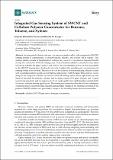Integrated Gas Sensing System of SWCNT and Cellulose Polymer Concentrator for Benzene, Toluene, and Xylenes
Author(s)
Im, Jisun; Sterner, Elizabeth Surles; Swager, Timothy M
Downloadsensors-16-00183.pdf (3.052Mb)
PUBLISHER_CC
Publisher with Creative Commons License
Creative Commons Attribution
Terms of use
Metadata
Show full item recordAbstract
An integrated cellulose polymer concentrator/single-walled carbon nanotube (SWCNT) sensing system is demonstrated to detect benzene, toluene, and xylenes (BTX) vapors. The sensing system consists of functionalized cellulose as a selective concentrator disposed directly on top of a conductive SWCNT sensing layer. Functionalized cellulose concentrator (top layer) selectively adsorbs the target analyte and delivers the concentrated analyte as near as possible to the SWCNT sensing layer (bottom layer), which enables the simultaneous concentrating and sensing within a few seconds. The selectivity can be achieved by functionalizing cellulose acetate with a pentafluorophenylacetyl selector that interacts strongly with the target BTX analytes. A new design of the integrated cellulose concentrator/SWCNT sensing system allows high sensitivity with limits of detection for benzene, toluene, and m-xylene vapors of 55 ppm, 19 ppm, and 14 ppm, respectively, selectivity, and fast responses ( < 10 s to reach equilibrium), exhibiting the potential ability for on-site, real-time sensing applications. The sensing mechanism involves the selective adsorption of analytes in the concentrator film, which in turn mediates changes in the electronic potentials at the polymer-SWCNT interface and potentially changes in the tunneling barriers between nanotubes. Keywords: cellulose; SWCNT; gas sensor; benzene; concentrator
Date issued
2016-02Department
Massachusetts Institute of Technology. Department of ChemistryJournal
Sensors
Publisher
MDPI AG
Citation
Im, Jisun et al. “Integrated Gas Sensing System of SWCNT and Cellulose Polymer Concentrator for Benzene, Toluene, and Xylenes.” Sensors 16, 12 (February 2016): 183 © 2016 The Author(s)
Version: Final published version
ISSN
1424-8220